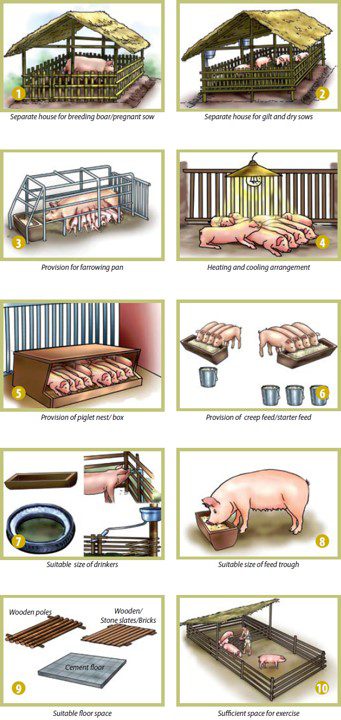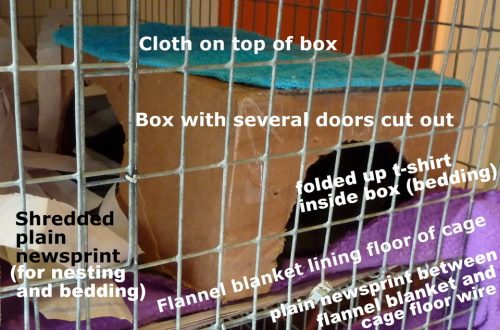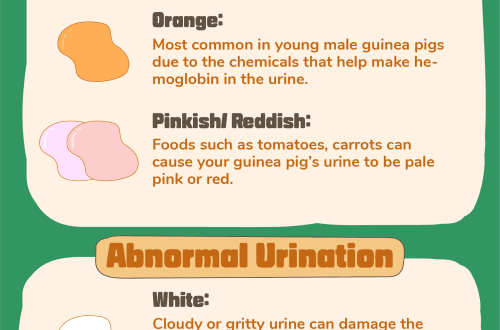
Choosing a home for a pig
Нередко сначала в дом попадает свинка, а потом уж начинают думать куда ее «поселить». Чаще всего для этой цели используют старый аквариум, что крайне нежелательно.
How to choose the right home for a guinea pig, what it should be, and what it should not be in any case, read the article Cage for a guinea pig
A guinea pig needs a large and properly equipped home to feel good and live comfortably. Anyone who has ever seen a pig “galloping” around the living room will understand that this animal needs space. Despite the fact that it looks clumsy and fat, the guinea pig makes jerky movements and is more mobile and faster than it might seem. You yourself will see this by trying to catch her between pieces of furniture when she runs away, having the prospect of returning to her house. The issue of the size of the pig’s dwelling becomes especially relevant if the pig cannot be released into the room or taken out into the yard.
The best option for keeping a guinea pig, according to experienced breeders, is a rack or a large cage.
Нередко сначала в дом попадает свинка, а потом уж начинают думать куда ее «поселить». Чаще всего для этой цели используют старый аквариум, что крайне нежелательно.
How to choose the right home for a guinea pig, what it should be, and what it should not be in any case, read the article Cage for a guinea pig
A guinea pig needs a large and properly equipped home to feel good and live comfortably. Anyone who has ever seen a pig “galloping” around the living room will understand that this animal needs space. Despite the fact that it looks clumsy and fat, the guinea pig makes jerky movements and is more mobile and faster than it might seem. You yourself will see this by trying to catch her between pieces of furniture when she runs away, having the prospect of returning to her house. The issue of the size of the pig’s dwelling becomes especially relevant if the pig cannot be released into the room or taken out into the yard.
The best option for keeping a guinea pig, according to experienced breeders, is a rack or a large cage.
The general principle is: the larger the cage, the better the life of the animal. If you build a cage with your own hands, you can choose the dimensions yourself, but so that you can freely carry it through the door. Any cage should be made of solid material.
An old cardboard box is not suitable for a guinea pig, even as a temporary shelter. The animal will quickly gnaw through the cardboard and, in addition, it will be saturated with urine, which will create ideal conditions for the emergence and reproduction of bacteria and lead to the creation of a biotope for parasites.
The general principle is: the larger the cage, the better the life of the animal. If you build a cage with your own hands, you can choose the dimensions yourself, but so that you can freely carry it through the door. Any cage should be made of solid material.
An old cardboard box is not suitable for a guinea pig, even as a temporary shelter. The animal will quickly gnaw through the cardboard and, in addition, it will be saturated with urine, which will create ideal conditions for the emergence and reproduction of bacteria and lead to the creation of a biotope for parasites.
The best option is a cage with a plastic bottom and a removable top. It can be easily disinfected with hot water and soap.
Ready-made cages for guinea pigs are commercially available in a wide range and at different prices, depending on size, quality, equipment, etc.
For keeping guinea pigs, rectangular-shaped metal cages, especially nickel-plated ones, are the most suitable. They are durable, hygienic, their openwork lattices let in a lot of light. Metal cages are not damaged by animals and do not deteriorate as a result of treatment with disinfectant solutions.
Cells made of organic glass, getinaks and other synthetic materials are hygienic and not affected by chemicals like metal ones, but they are “afraid” of hot water and high temperature.
Combined cages are less durable than metal cages, but they are easier to make and cheaper.
The best option is a cage with a plastic bottom and a removable top. It can be easily disinfected with hot water and soap.
Ready-made cages for guinea pigs are commercially available in a wide range and at different prices, depending on size, quality, equipment, etc.
For keeping guinea pigs, rectangular-shaped metal cages, especially nickel-plated ones, are the most suitable. They are durable, hygienic, their openwork lattices let in a lot of light. Metal cages are not damaged by animals and do not deteriorate as a result of treatment with disinfectant solutions.
Cells made of organic glass, getinaks and other synthetic materials are hygienic and not affected by chemicals like metal ones, but they are “afraid” of hot water and high temperature.
Combined cages are less durable than metal cages, but they are easier to make and cheaper.
It is better to choose a place for installing a cage in an apartment without hurrying. Drafts are a very big threat. If the cage is in a place where there is a risk of drafts, the animal may catch a cold or get inflammation of the eyes. The place for the cell should be chosen very carefully. It is absolutely unacceptable to keep guinea pigs in dark and cool rooms, for example, in a residential basement. Only a well-lit and dry place can guarantee a long and healthy life for a guinea pig.
The air temperature in the room where the guinea pig is kept should be 22 ° C, relative humidity 45-55%, illumination 60 lux. High temperature and low air mobility, combined with high humidity, inhibit heat transfer, which, in turn, causes overheating of the body. At the same time, lethargy appears in animals, appetite and resistance to diseases decrease, and metabolism slows down. Negatively affects the condition of animals and high humidity in combination with low temperatures.
The proximity of the window, heating appliances, TV is undesirable. They do not like pigs and bright light, but it will not be difficult to shade part of the cage. It is better to install the cage on a bedside table or on some kind of stand, and not on the floor.
Watching pigs from the side is much more interesting than from above, and temperature fluctuations near the floor can be large (especially in winter when airing).
Whether the cage is in the house or in the yard, its basic equipment is the same. The house, or the so-called box for rest and sleep, without a bottom and a hole on the side, is the main element that guarantees the little tenant peace and quiet, as well as shade if the cage is exposed to the sun. To prevent the pig from using it as a springboard, you can stretch a strip of fabric over it along the top of the cage.
A feeder and a drinking bowl under the water are also needed. As a drinker, an upside-down bottle with a ball valve is the best option. Such a glass or plastic drinker, which can be bought in many zoological shops, is inexpensive and incomparably more hygienic than a bowl: the water does not get dirty and does not spill. Unfortunately, algae quickly start and develop in it, mainly when it is exposed to direct sunlight. This problem can be solved by using a small bottle brush, which can also be used to clean the excretory tube. However, there are sometimes guinea pigs that do not recognize drinking from a bottle and do not drink at all in this case. The owner is obliged to provide such an animal with fresh green food daily.
Feeding troughs should be of a comfortable design and of good quality. It is best to use ceramic or plastic. They are easy to clean and at the same time they must be heavy enough so that the animal cannot turn them over, leaning on the edge with its paws. The feeder should have a wide base, like a dog bowl.
The feeder can be retractable, outdoor or attached to the floor.
The bottom of the cage is most often sprinkled with sawdust or shavings; sawdust is also the main component of the finished bedding specially prepared for small animals. The layer of sawdust or shavings should be 2-3 cm. Softwood sawdust is not suitable for bedding – they can cause constipation when eaten by animals and sticking wool in long-haired breeds. Do not use newspapers either due to possible ink poisoning (these animals will eat both shavings and newspapers). If you do not have sawdust for bedding, toilet or wrapping paper, straw is temporarily used.
Regardless of the type of grazing material, it is recommended to clean the cage once or twice a week, according to its size and the number of animals living in it.
The larger the area of the cell, the less often it has to be removed. But, if you gave the animals plenty of herbs, cucumbers or watermelon peels, it is possible that you will have to replace the bedding in a day. In practice, the signal for cleaning is the appearance of a slight smell.
It is better to choose a place for installing a cage in an apartment without hurrying. Drafts are a very big threat. If the cage is in a place where there is a risk of drafts, the animal may catch a cold or get inflammation of the eyes. The place for the cell should be chosen very carefully. It is absolutely unacceptable to keep guinea pigs in dark and cool rooms, for example, in a residential basement. Only a well-lit and dry place can guarantee a long and healthy life for a guinea pig.
The air temperature in the room where the guinea pig is kept should be 22 ° C, relative humidity 45-55%, illumination 60 lux. High temperature and low air mobility, combined with high humidity, inhibit heat transfer, which, in turn, causes overheating of the body. At the same time, lethargy appears in animals, appetite and resistance to diseases decrease, and metabolism slows down. Negatively affects the condition of animals and high humidity in combination with low temperatures.
The proximity of the window, heating appliances, TV is undesirable. They do not like pigs and bright light, but it will not be difficult to shade part of the cage. It is better to install the cage on a bedside table or on some kind of stand, and not on the floor.
Watching pigs from the side is much more interesting than from above, and temperature fluctuations near the floor can be large (especially in winter when airing).
Whether the cage is in the house or in the yard, its basic equipment is the same. The house, or the so-called box for rest and sleep, without a bottom and a hole on the side, is the main element that guarantees the little tenant peace and quiet, as well as shade if the cage is exposed to the sun. To prevent the pig from using it as a springboard, you can stretch a strip of fabric over it along the top of the cage.
A feeder and a drinking bowl under the water are also needed. As a drinker, an upside-down bottle with a ball valve is the best option. Such a glass or plastic drinker, which can be bought in many zoological shops, is inexpensive and incomparably more hygienic than a bowl: the water does not get dirty and does not spill. Unfortunately, algae quickly start and develop in it, mainly when it is exposed to direct sunlight. This problem can be solved by using a small bottle brush, which can also be used to clean the excretory tube. However, there are sometimes guinea pigs that do not recognize drinking from a bottle and do not drink at all in this case. The owner is obliged to provide such an animal with fresh green food daily.
Feeding troughs should be of a comfortable design and of good quality. It is best to use ceramic or plastic. They are easy to clean and at the same time they must be heavy enough so that the animal cannot turn them over, leaning on the edge with its paws. The feeder should have a wide base, like a dog bowl.
The feeder can be retractable, outdoor or attached to the floor.
The bottom of the cage is most often sprinkled with sawdust or shavings; sawdust is also the main component of the finished bedding specially prepared for small animals. The layer of sawdust or shavings should be 2-3 cm. Softwood sawdust is not suitable for bedding – they can cause constipation when eaten by animals and sticking wool in long-haired breeds. Do not use newspapers either due to possible ink poisoning (these animals will eat both shavings and newspapers). If you do not have sawdust for bedding, toilet or wrapping paper, straw is temporarily used.
Regardless of the type of grazing material, it is recommended to clean the cage once or twice a week, according to its size and the number of animals living in it.
The larger the area of the cell, the less often it has to be removed. But, if you gave the animals plenty of herbs, cucumbers or watermelon peels, it is possible that you will have to replace the bedding in a day. In practice, the signal for cleaning is the appearance of a slight smell.
When you return from the store with a small, trembling creature that, with its legs spread wide and eyes wide in fear, will emerge from the box, you will find it hard to believe that soon it will greet you with a loud squeal, barely hearing your steps. In fact, it does not take much effort to win the friendship of this little fluffy animal. Before this happens, however, a few days of imperturbable calm must be guaranteed to him, so that he may become accustomed to his new surroundings. It is important, at least initially, to avoid any sudden movements or unexpected noises near the cage. A guinea pig has much more sensitive hearing than a human and is therefore much more sensitive to loud sounds. Her sense of smell is also much better developed than that of a person; but her eyesight is worse.
You will soon recognize the places she likes to be scratched – below the neck, above the nose, behind the ears. When the pig falls asleep in your lap, purring softly in response to gentle caresses, this will mean that you have won her trust. The taming process can, of course, be accelerated by “bribes” in the form of fresh salad or other goodies.
If you keep several guinea pigs, you will quickly notice that each has its own personality. One may be surprised to hear about the “character” of such a small animal, but this is neither a lie nor an exaggeration. Each has its own “personality”; The guinea pig is not the mindless wad of fur and muscle that—often unfairly—she is thought to be.
Those who have been keeping and breeding guinea pigs for many years know that each of them is unique in its own way, in a certain sense. Many were tamed easily, while others remained distrustful. Some managed to endure almost everything without resistance, others were distinguished by unshakable perseverance. However, no matter how much a guinea pig is tamed and attached to a person, it can never be trained.
I leave the conclusion to you to make yourself: whether this is a manifestation of stupidity, or intelligence; probably neither one nor the other, but only an innate trait of the animal’s character.
While cleaning the cage, you will have to let the guinea pigs out so that they can run freely around the room. Once guinea pigs overcome their initial shyness, they will use the freedom given to them with a riot of elements, arranging frantic races. The speed that these seemingly clumsy animals develop is, in truth, amazing.
A guinea pig that roams freely around the house should not, however, be left unsupervised even for a minute. For there many dangers lie in wait for her, in which one may not even be aware of. Without a doubt, the greatest danger is electrical wires. The pig constantly “discovers” new objects for itself, and being a typical rodent, tries everything on the tooth. If he starts to gnaw on electrical wires – instant death!
The guinea pig easily gets entangled, clinging with its claws, in all sorts of tissues that it meets on its way. This can lead to stretching or dislocation of the joints of her limbs and, of course, damage to the tissue itself. When an animal runs around the room, you need to constantly watch so as not to step on it, because you can not notice such a small creature under your feet. It can also be pinched by the door, or the door itself can slam shut at the most inopportune moment.
When you return from the store with a small, trembling creature that, with its legs spread wide and eyes wide in fear, will emerge from the box, you will find it hard to believe that soon it will greet you with a loud squeal, barely hearing your steps. In fact, it does not take much effort to win the friendship of this little fluffy animal. Before this happens, however, a few days of imperturbable calm must be guaranteed to him, so that he may become accustomed to his new surroundings. It is important, at least initially, to avoid any sudden movements or unexpected noises near the cage. A guinea pig has much more sensitive hearing than a human and is therefore much more sensitive to loud sounds. Her sense of smell is also much better developed than that of a person; but her eyesight is worse.
You will soon recognize the places she likes to be scratched – below the neck, above the nose, behind the ears. When the pig falls asleep in your lap, purring softly in response to gentle caresses, this will mean that you have won her trust. The taming process can, of course, be accelerated by “bribes” in the form of fresh salad or other goodies.
If you keep several guinea pigs, you will quickly notice that each has its own personality. One may be surprised to hear about the “character” of such a small animal, but this is neither a lie nor an exaggeration. Each has its own “personality”; The guinea pig is not the mindless wad of fur and muscle that—often unfairly—she is thought to be.
Those who have been keeping and breeding guinea pigs for many years know that each of them is unique in its own way, in a certain sense. Many were tamed easily, while others remained distrustful. Some managed to endure almost everything without resistance, others were distinguished by unshakable perseverance. However, no matter how much a guinea pig is tamed and attached to a person, it can never be trained.
I leave the conclusion to you to make yourself: whether this is a manifestation of stupidity, or intelligence; probably neither one nor the other, but only an innate trait of the animal’s character.
While cleaning the cage, you will have to let the guinea pigs out so that they can run freely around the room. Once guinea pigs overcome their initial shyness, they will use the freedom given to them with a riot of elements, arranging frantic races. The speed that these seemingly clumsy animals develop is, in truth, amazing.
A guinea pig that roams freely around the house should not, however, be left unsupervised even for a minute. For there many dangers lie in wait for her, in which one may not even be aware of. Without a doubt, the greatest danger is electrical wires. The pig constantly “discovers” new objects for itself, and being a typical rodent, tries everything on the tooth. If he starts to gnaw on electrical wires – instant death!
The guinea pig easily gets entangled, clinging with its claws, in all sorts of tissues that it meets on its way. This can lead to stretching or dislocation of the joints of her limbs and, of course, damage to the tissue itself. When an animal runs around the room, you need to constantly watch so as not to step on it, because you can not notice such a small creature under your feet. It can also be pinched by the door, or the door itself can slam shut at the most inopportune moment.





